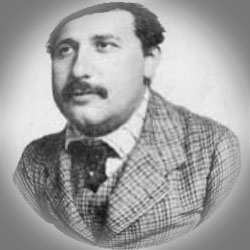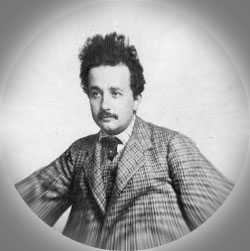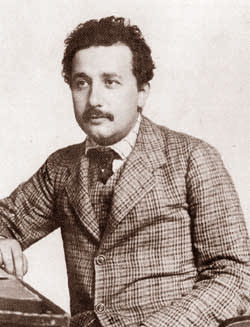Albert Einstein
He studied in Eidgenoessische Technische Hochschule in Zuerich (ETH), but could not get a job in any university; so he worked as a patent clerk (photo below) in Bern for a while (1902-1909). After this, he taught at Zuerich (1909-1911), Prague (1911-1912), Zuerich (1912-1914), Berlin (1914-1933), and finally became a professor at Institute for Advanced Study, Princeton (1932-1955).
[Original photo in Albert Einstein Archives, Hebrew Univ. of Jerusalem]
While in Bern, he continued his work on physics, and he published three important papers (among others) in 1905. One is the paper on photo-electric effect, proposing his light quanta hypothesis, drawing on Max Planck's quantum hypothesis; and he was awarded the Nobel Prize in 1921 for this work. Another is the paper on special relativity, which brought a revolution in physics in the 20th century. He extended the idea of this paper to dynamics involving gravity; this gave birth to general relativity (1915), in which gravity can be represented by a curvature of spacetime.
His two theories of relativity had a great impact upon many fields of human activities. Philosophy of Science in particular owes a great deal to him; for instance, some of the major proponents of logical empiricism were enthusiastic about relativity, because of (what they took as) its epistemological implications, such as the conventionality of simultaneity or the verificationistic critique of spacetime theories. Thus the contemporary philosophy of space and time cannot be studied without knowledge of these theories which utilizes non-Euclidean geometries (see Einstein with a "positive curvature" [left] and Einstein with a "negative curvature" [right]; notice that even in Minkowski spacetime [which is flat] of special relativity, its metric is quite different from the standard Euclidean metric).
 |
 |
However, his own philosophy seems to have made him quite reluctant to accept another great theory of this century, quantum mechanics. Despite long and many controversies with Bohr, he was never happy with quantum mechanics.
It must also be noted that his leadership with respect to the scientist's role in social affairs was exemplary and influential. Russell-Einstein Manifesto (1955) gave birth to Pugwash Conferences. Since he was a real human, not an "ideal scientist", there are many intriguing questions about his private life, and recent biographies are more and more concerned with such aspects; but whatever the details of his private life may have been, they detract nothing from his reputation as a scientist.
To Einstein page in the NobelFoundation
A good scholarly biography is Abraham Pais, 'Subtle is the Lord ...' , Oxford University Press, 1982.
BACK TO EINSTEIN PICTURE/ BACK TO EINSTEIN PICTURE 2 / BACK TO EINSTEIN PICTURE 3
